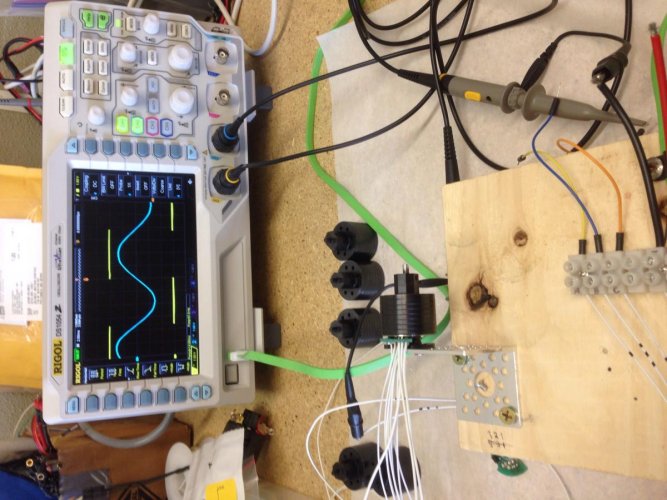I bet its really tough trying to keep press fit tolerance on 6061, it is hard enough to just keep the tools engaged consistently on that gummy material. You probably spent more time dialing in the feeds to get a good chip than anything else. The worst issue I have had on tolerance is when the feeds weren't pushing the chips right and they were coming back into the cutting zone, that really screws up everything!
The CNC has been working hard the past few weeks, and I've been gathering more intel on how to work my machine efficiently with the temp swings. On monday I installed a temp probe in the coolant tank to keep an eye on the "real" temp of the machine, or at least the best indicator of the system average so far. This week the coolant would drop between 62 and 64f at night, then climb to 72 to 75f by days end depending on how many hours I ran the machine. The biggest jump is on the first few parts when the cutting inserts rise to operating temp and start cutting more efficiently, as much as 0.0004" change from part 1 to 2. I found that banging out parts with no rest is the best method, as even a minute rest between parts makes the final size jump around almost randomly. Because of this we tend to have a few oversized parts at first, better to oversize than undersize! So I'm going to set up the little CNC Taig with a diamond bit to skim off parts that didn't meet specs on this last batch.
Since the Mazak has been running a lot, we are running into a coolant fog problem in that part of the shop. At first I didn't know if it was the coolant or the compressor exhausting oil, and with the new compressor we seemed to get a good break in the haze. But last week it was evident there was still a fog in the shop so this past Monday I rerouted the coolant spray so it wasn't beating against the chuck jaws. It really helped a lot, seemed to have solved it. But after running for 6 hours straight on Thursday it was obvious the fog was back although much better. Maybe some of it is smoke from the steel burning a bit too. So now just one more thing to buy for the shop, a mist collector. There is a whole industry dedicated to this problem. I suppose that 10" jaws beating coolant up at 4000rpm really flings it into a fine mist, and since the mist is hot it literally steams out the top when I open the door.
<iframe width="420" height="315" src="//www.youtube.com/embed/fCat_H_K5qU" frameborder="0" allowfullscreen></iframe>
The CNC has been working hard the past few weeks, and I've been gathering more intel on how to work my machine efficiently with the temp swings. On monday I installed a temp probe in the coolant tank to keep an eye on the "real" temp of the machine, or at least the best indicator of the system average so far. This week the coolant would drop between 62 and 64f at night, then climb to 72 to 75f by days end depending on how many hours I ran the machine. The biggest jump is on the first few parts when the cutting inserts rise to operating temp and start cutting more efficiently, as much as 0.0004" change from part 1 to 2. I found that banging out parts with no rest is the best method, as even a minute rest between parts makes the final size jump around almost randomly. Because of this we tend to have a few oversized parts at first, better to oversize than undersize! So I'm going to set up the little CNC Taig with a diamond bit to skim off parts that didn't meet specs on this last batch.
Since the Mazak has been running a lot, we are running into a coolant fog problem in that part of the shop. At first I didn't know if it was the coolant or the compressor exhausting oil, and with the new compressor we seemed to get a good break in the haze. But last week it was evident there was still a fog in the shop so this past Monday I rerouted the coolant spray so it wasn't beating against the chuck jaws. It really helped a lot, seemed to have solved it. But after running for 6 hours straight on Thursday it was obvious the fog was back although much better. Maybe some of it is smoke from the steel burning a bit too. So now just one more thing to buy for the shop, a mist collector. There is a whole industry dedicated to this problem. I suppose that 10" jaws beating coolant up at 4000rpm really flings it into a fine mist, and since the mist is hot it literally steams out the top when I open the door.
<iframe width="420" height="315" src="//www.youtube.com/embed/fCat_H_K5qU" frameborder="0" allowfullscreen></iframe>




